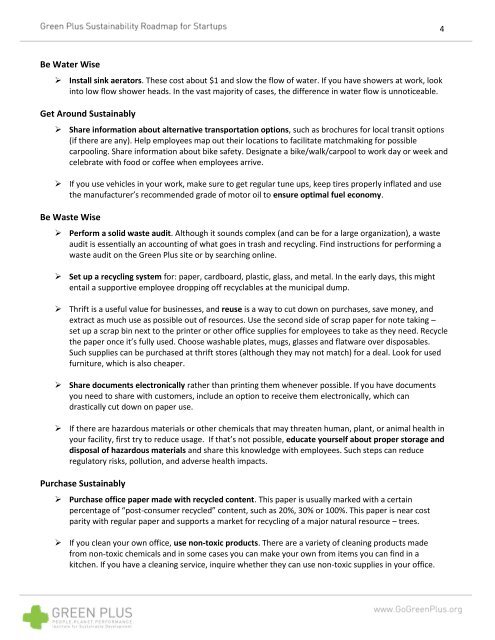Sustainability Roadmap for Startups - Green Plus
Sustainability Roadmap for Startups - Green Plus
Sustainability Roadmap for Startups - Green Plus
Create successful ePaper yourself
Turn your PDF publications into a flip-book with our unique Google optimized e-Paper software.
4<br />
Be Water Wise<br />
‣ Install sink aerators. These cost about $1 and slow the flow of water. If you have showers at work, look<br />
into low flow shower heads. In the vast majority of cases, the difference in water flow is unnoticeable.<br />
Get Around Sustainably<br />
‣ Share in<strong>for</strong>mation about alternative transportation options, such as brochures <strong>for</strong> local transit options<br />
(if there are any). Help employees map out their locations to facilitate matchmaking <strong>for</strong> possible<br />
carpooling. Share in<strong>for</strong>mation about bike safety. Designate a bike/walk/carpool to work day or week and<br />
celebrate with food or coffee when employees arrive.<br />
‣ If you use vehicles in your work, make sure to get regular tune ups, keep tires properly inflated and use<br />
the manufacturer’s recommended grade of motor oil to ensure optimal fuel economy.<br />
Be Waste Wise<br />
‣ Per<strong>for</strong>m a solid waste audit. Although it sounds complex (and can be <strong>for</strong> a large organization), a waste<br />
audit is essentially an accounting of what goes in trash and recycling. Find instructions <strong>for</strong> per<strong>for</strong>ming a<br />
waste audit on the <strong>Green</strong> <strong>Plus</strong> site or by searching online.<br />
‣ Set up a recycling system <strong>for</strong>: paper, cardboard, plastic, glass, and metal. In the early days, this might<br />
entail a supportive employee dropping off recyclables at the municipal dump.<br />
‣ Thrift is a useful value <strong>for</strong> businesses, and reuse is a way to cut down on purchases, save money, and<br />
extract as much use as possible out of resources. Use the second side of scrap paper <strong>for</strong> note taking –<br />
set up a scrap bin next to the printer or other office supplies <strong>for</strong> employees to take as they need. Recycle<br />
the paper once it’s fully used. Choose washable plates, mugs, glasses and flatware over disposables.<br />
Such supplies can be purchased at thrift stores (although they may not match) <strong>for</strong> a deal. Look <strong>for</strong> used<br />
furniture, which is also cheaper.<br />
‣ Share documents electronically rather than printing them whenever possible. If you have documents<br />
you need to share with customers, include an option to receive them electronically, which can<br />
drastically cut down on paper use.<br />
‣ If there are hazardous materials or other chemicals that may threaten human, plant, or animal health in<br />
your facility, first try to reduce usage. If that’s not possible, educate yourself about proper storage and<br />
disposal of hazardous materials and share this knowledge with employees. Such steps can reduce<br />
regulatory risks, pollution, and adverse health impacts.<br />
Purchase Sustainably<br />
‣ Purchase office paper made with recycled content. This paper is usually marked with a certain<br />
percentage of “post-consumer recycled” content, such as 20%, 30% or 100%. This paper is near cost<br />
parity with regular paper and supports a market <strong>for</strong> recycling of a major natural resource – trees.<br />
‣ If you clean your own office, use non-toxic products. There are a variety of cleaning products made<br />
from non-toxic chemicals and in some cases you can make your own from items you can find in a<br />
kitchen. If you have a cleaning service, inquire whether they can use non-toxic supplies in your office.


